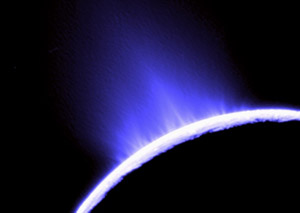Data collected during two close flybys of Saturn’s moon Enceladus by NASA’s Cassini spacecraft add more fuel to the fire about the Saturnian ice world containing sub-surface liquid water, according to a report in the July 23 issue of the journal Nature that is co-authored by a planetary researcher from Washington University in St. Louis.

NASA/JPL/Space Science Institute
Saturn’s moon Enceladus, seen by the Cassini spacecraft.
The data, collected by Cassini’s Ion and Neutral Mass Spectrometer during Enceladus flybys in July and Oct. 2008, includes the first definitive evidence that ammonia is among the complex chemicals, including organic ones, that exist in the vapor and icy particles in plumes erupting from the surface of Enceladus.
“Ammonia is sort of a holy grail for icy volcanism,” said William B. McKinnon, Ph.D., co-author of the Nature report and professor of earth and planetary sciences in Arts & Sciences at Washington University in St. Louis. “This is the first time we’ve found it for sure on an icy satellite of a giant planet. It is probably everywhere in the Saturn system.”
McKinnon, who has been researching icy moons of the Solar System for NASA using data from the Voyager, Galileo, and Cassini missions, notes that Enceladus has a special status.
“That Enceladus is erupting, if you will, right now before our eyes, gives us an incredible opportunity,” McKinnon said. “We can fly Cassini right through the plumes and make precise chemical measurements. This gives us a tool to understand the activity, what drives it, what it implies, a tool that no amount of image analysis can duplicate.”
On Earth, the presence of ammonia means the potential for sparkling clean floors and counter tops. In space, the presence of ammonia provides strong evidence for the existence of at least some liquid water.
How could ammonia equate to liquid water inside an ice-covered moon in one of the chillier neighborhoods of our solar system? As many a homeowner interested in keeping their abodes spick and span know, ammonia promptly dissolves in water. But what many people do not realize is that ammonia acts as antifreeze, keeping water liquid at lower temperatures than would otherwise be possible. With the presence of ammonia, water can exist in a liquid state to temperatures as low as 176 degrees Kelvin (-143 degrees Fahrenheit).
“Given that temperatures near 180 Kelvin (-136 degrees Fahrenheit) have been measured near the fractures on Enceladus where the jets emanate, we think we have an excellent argument for some liquid water in the interior,” said Hunter Waite, the Cassini Ion and Neutral Mass Spectrometer Lead Scientist from the Southwest Research Institute in San Antonio, Texas.
McKinnon added, “We also detected argon-40 leaking out of Enceladus. Argon-40 is produced by the decay of radioactive potassium-40, and we see so much of it that it almost guarantees that liquid water existed inside Enceladus, at least at one time.”
Cassini discovered water vapor and particles spewing from Enceladus in 2005. Since then, scientists have been trying to determine if the plume originates from a liquid source inside the moon or is due to other causes.
Just how much water is contained within Enceladus’ icy interior is still up for debate. So far, Cassini has made five flybys of Enceladus, one of the chief targets for Cassini’s extended mission. Two close flybys are scheduled for November of this year, and two more close flybys are scheduled for April and May or 2010. Data collected during these future flybys may help settle the debate.
“Enceladus is the most active of all the icy moons,” said McKinnon. “Despite its modest size, it has a lot to teach us about how all moons operate, including the big question of whether they contain potentially habitable environments. It truly is ‘the little moon that could.'”
The Cassini-Huygens mission is a cooperative project of NASA, the European Space Agency and the Italian Space Agency. The Cassini orbiter was designed, developed and assembled at NASA’s Jet Propulsion Laboratory. JPL manages the mission for the Science Mission Directorate at NASA Headquarters in Washington.
# # #
Editor’s Note: This release has been adapted from one issued by NASA and available online at: http://www.jpl.nasa.gov/news/features.cfm?feature=2238.
More information about the Cassini mission is available at http://www.nasa.gov/cassini or http://saturn.jpl.nasa.gov.